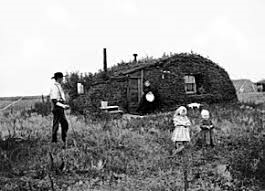By Dorothy Seehausen

After a long, snowy Wisconsin winter, it was time to take up my daughter’s invitation to visit my granddaughter, the anthropology major, at Augustana University in Sioux Falls, South Dakota. It was her 20th birthday and they promised me an hour on my own to do research. Her dorm is within walking distance of the Krause Research Library at the Center for Western Studies (CWS), so while they took a stroll around the campus enjoying the warmish spring-like weather I headed over to the CWS for a frolic of my own – piecing together the awesome story of our pioneer ancestors.
Located at 2001 S. Summit Avenue in Sioux Falls, the CWS houses a welcome center, gift shop, museum, and library. Most of its many offerings are free, and include the new permanent museum exhibits Voices of the Northern Plains, as well as the Krause Research Library which houses 40,000 volumes on the Great Plains/American West. Partnerships with the South Dakota State Historical Society, the South Dakota Archaeological Society and the University of Nebraska’s Center for Great Plains Studies aid the CWS in their goal to stimulate interest in the heritage of South Dakota. There is also online access to thousands of photos and documents in the library’s database Northern Plains Peoples & Places.
The Krause Research Library is upstairs, its walls appropriately decorated with long rows of books I wished I had time to get lost in. Off to the left at the top of the stairs an ample staff room awaits with staff to assist the researcher’s every whim. Open to the public, family historians either can browse the shelves themselves or hire a researcher to work with. Since my time and funds were limited, I decided to sit at the computer looking for books, articles, magazines – anything that contained the history of homesteading in South Dakota, my latest family history project.
My interest in South Dakota started when I married in 1961. My husband’s grandparents (my granddaughter’s great-greats), Thomas and Ida Mae Shanahan purchased 160 acres of homestead land for a filing fee of $18 in Lyman County, South Dakota in 1908. Their story is a microcosm of the lives of thousands of homesteaders who poured into Dakota Territory from 1860 to 1920, thanks to the homestead act of 1862.
Using “homesteading” and “South Dakota” as my search terms, a few minutes later I discovered “Drawn to the Land: Homesteading Dakota.” This guide is a 20-page booklet, digitized and available online, describing the South Dakota State Historical Society’s traveling exhibit to celebrate the state’s 125th anniversary. It includes an overview of the homesteading experience from the first purchase of 160 acres of land to proving it up and all the hardships, pitfalls and successes in between, including pictures of the one room sod huts many families had to live in.
I downloaded the guide on my flash drive, happy as great-great grandpa Shanahan must have been as he stood on his land for the first time, a land patent in his pocket and a dream in his heart.
So how big actually is 160 acres? The Mall of America is about 96 acres; Vatican City is about 110; Ellis Island is 27.40 acres; Buckingham Palace itself has 19 acres of floor space. Fort Knox is 109,054 acres. And if you had 168 football fields? They would fit on your 160 acres of land.
